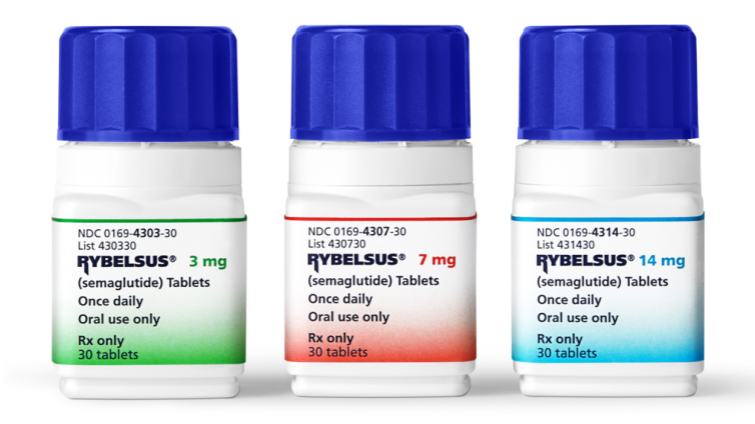Both medications offer effective options for managing type 2 diabetes, allowing for personalized treatment plans. The choice between Rybelsus and Ozempic depends on individual patient preferences, tolerance for administration methods, and specific medical considerations.
Rybelsus Short Review

Rybelsus is primarily prescribed for the treatment of type 2 diabetes in adults. It is an oral medication that belongs to the class of glucagon-like peptide-1 (GLP-1) receptor agonists. Rybelsus is unique because it’s the first oral GLP-1 receptor agonist available for diabetes management. The main characteristics are:
- The method of administration is an oral tablet, taken once daily with or without food.
- Generally, it takes effect within 1-2 hours after ingestion.
- It provides sustained blood sugar control throughout the day.
- In clinical trials, Rybelsus has demonstrated efficacy in reducing HbA1c levels and promoting weight loss in patients with type 2 diabetes.
- Common side effects may include nausea, diarrhea, and abdominal pain. Hypoglycemia (low blood sugar) is also a potential risk.
- It offers the convenience of oral administration, eliminating the need for injections. Suitable for individuals who prefer or have difficulty with injections.
Ozempic Short Review

Ozempic is also used for the management of type 2 diabetes in adults. Unlike Rybelsus, Ozempic is administered as a subcutaneous injection, falling under the GLP-1 receptor agonist category. The main characteristics are:
- The method of administration is subcutaneous injection, typically administered once a week. The injection is usually given in the abdomen, thigh, or upper arm.
- It shows a gradual onset of action, with therapeutic effects lasting up to a week.
- The once-weekly dosing contributes to patient convenience.
- Clinical studies have shown that Ozempic effectively improves glycemic control, reduces the risk of cardiovascular events, and aids in weight management.
- Adverse effects may include nausea, vomiting, and diarrhea. Hypoglycemia can occur, mainly when used in conjunction with other diabetes medications.
- It requires a weekly injection, which may be a drawback for patients who are averse to needles. However, the infrequent dosing may be appealing to some.
Ingredients of Rybelsus and Ozempic
Let’s break down the ingredients of Rybelsus and Ozempic to see where they align and where they differ. The table below provides a clear visual representation of the active and inactive ingredients shared between Rybelsus and Ozempic, as well as the differences in their inactive components.
|
|
Rybelsus Ingredients |
Ozempic Ingredients |
|
Active Ingredient |
Semaglutide |
|
|
Inactive Ingredients |
Ferric oxide red Ferric oxide yellow Hypromellose Lactose monohydrate Magnesium stearate Microcrystalline cellulose Sodium lauryl sulfate Talc Titanium dioxide Triacetin |
Disodium phosphate dihydrate M-Cresol Methionine Polysorbate 20 Sodium chloride Water for injection |
Both Rybelsus and Ozempic share the same active ingredient, which is semaglutide. Semaglutide is a glucagon-like peptide-1 (GLP-1) receptor agonist, a class of medications used to manage type 2 diabetes.
While both medications contain semaglutide, the inactive ingredients differ. These inactive components are substances that do not have therapeutic effects but are crucial for the medication’s formulation, stability, or appearance.
It’s essential to note that the differences in inactive ingredients may contribute to variations in factors such as the route of administration, onset of action, and potential side effects. Some individuals may have allergies or sensitivities to specific inactive ingredients, so it’s crucial to consider these components when prescribing or using these medications.
Always consult a healthcare professional or pharmacist for personalized information regarding allergies, sensitivities, or any concerns related to the ingredients in these medications.
Forms of Rybelsus and Ozempic
Rybelsus Form: Oral Tablets

Pros:
- Convenience: Rybelsus offers the convenience of oral administration, eliminating the need for injections. This can be preferable for individuals who have a fear of needles or discomfort with injections.
- Patient Preference: Some individuals may find taking a tablet more convenient and discreet than administering injections, leading to better adherence to the treatment plan.
- Easy Storage: Tablets are typically easy to store and transport, requiring no special conditions like refrigeration.
Cons:
- Gastrointestinal Side Effects: Rybelsus, being an oral medication, may be associated with gastrointestinal side effects such as nausea and diarrhea in some individuals.
- Dosing Frequency: Rybelsus is taken daily, which may be a consideration for individuals who prefer less frequent dosing.
Ozempic Form: Subcutaneous Injection Pen

Pros:
- Infrequent Dosing: Ozempic is administered once a week, offering a more extended dosing interval compared to Rybelsus. This can be advantageous for individuals who prefer less frequent injections.
- Stable Blood Sugar Control: The once-weekly administration of Ozempic contributes to stable blood sugar control throughout the week.
- Weight Management: Ozempic has shown effectiveness in promoting weight loss, which may be a desirable outcome for some individuals with diabetes.
Cons:
- Injection Site Reactions: Subcutaneous injections may lead to injection site reactions such as redness or irritation.
- Needle Anxiety: Individuals who are averse to needles may find the weekly injections challenging, potentially impacting adherence to the treatment plan.
- Storage Requirements: The pen needs to be appropriately stored, and the injection should be administered at room temperature. Refrigeration may be necessary for long-term storage.
The choice between Rybelsus tablets and Ozempic pens often comes down to individual preferences, lifestyle, and the ability to manage potential side effects. While Rybelsus offers the convenience of oral administration, Ozempic provides the advantage of less frequent dosing. Healthcare professionals consider these factors, along with the patient’s medical history and preferences, to determine the most suitable treatment option.
Uses of Rybelsus and Ozempic
Let’s check the uses of Rybelsus and Ozempic, highlighting their similarities and differences.
|
|
Rybelsus Uses |
Ozempic Uses |
|
Primary Use |
Rybelsus is primarily prescribed for the treatment of type 2 diabetes in adults. |
Ozempic is also prescribed for the treatment of type 2 diabetes in adults. |
|
Mechanism of Action |
Acts as a glucagon-like peptide-1 (GLP-1) receptor agonist, stimulating insulin secretion and inhibiting glucagon release. Helps regulate blood sugar levels by promoting insulin sensitivity and reducing glucose production in the liver.
|
Functions as a GLP-1 receptor agonist, similar to Rybelsus, leading to increased insulin secretion and decreased glucagon release. Aids in regulating blood sugar levels and improving overall glycemic control.
|
|
Additional Benefits |
Rybelsus has been associated with weight loss, making it a favorable option for individuals with diabetes who may also benefit from weight management. |
Ozempic has shown efficacy in reducing the risk of cardiovascular events, making it a valuable option for individuals with diabetes at risk of cardiovascular complications. It is associated with weight loss, contributing to its appeal for patients seeking both glycemic control and weight management. |
Similarities
- Type 2 Diabetes: Both Rybelsus and Ozempic are used to manage type 2 diabetes, making them part of the same therapeutic class as GLP-1 receptor agonists.
- GLP-1 Receptor Agonists: The primary mechanism of action for both medications involves the activation of GLP-1 receptors, leading to improved insulin sensitivity and glucose regulation.
Differences
- Cardiovascular Benefits: While both medications aid in glycemic control, Ozempic has specifically demonstrated cardiovascular benefits, making it a preferred choice for individuals with diabetes and cardiovascular risk factors.
- Administration Route: Rybelsus is an oral medication taken in tablet form, whereas Ozempic is administered as a subcutaneous injection, typically given once a week.
Understanding these similarities and differences helps healthcare professionals tailor treatment plans to individual patient needs, considering factors such as cardiovascular health, preference for oral or injectable medications, and the desire for weight management.
What Are the Benefits of Rybelsus and Ozempic?
Both Rybelsus and Ozempic offer several benefits for individuals with type 2 diabetes. Let’s explore the key advantages of each medication:
Shared Benefits
- Improved Insulin Sensitivity: Both medications belong to the GLP-1 receptor agonist class, offering the common benefit of improved insulin sensitivity and glucose regulation.
- Individualized Treatment: The availability of multiple medications allows healthcare professionals to tailor treatment plans to individual patient needs, considering factors such as cardiovascular health, weight management goals, and patient preferences.
Rybelsus Benefits
- Convenience of Oral Administration: Rybelsus is administered orally, offering a convenient option for individuals who prefer not to use injectable medications.
- Improved Blood Sugar Control: As a GLP-1 receptor agonist, Rybelsus helps regulate blood sugar levels by increasing insulin secretion and reducing glucagon release.
- Weight Loss: Rybelsus has been associated with weight loss, making it a favorable choice for individuals with diabetes who want to manage their weight.
Ozempic Benefits
- Reduced Cardiovascular Risk: Ozempic has demonstrated cardiovascular benefits, reducing the risk of major cardiovascular events in individuals with type 2 diabetes. This makes it a valuable option for those with cardiovascular risk factors.
- Less Frequent Dosing (Weekly Administration): Ozempic is administered once a week, providing a less frequent dosing schedule compared to daily medications. This may improve adherence and convenience for some patients.
- Weight Loss: Similar to Rybelsus, Ozempic is associated with weight loss, providing an additional benefit for individuals with diabetes aiming for weight management.
Understanding these benefits helps healthcare providers and individuals with diabetes make informed decisions when selecting a treatment plan. It’s essential to consult a healthcare professional to determine the most suitable medication for you.


























